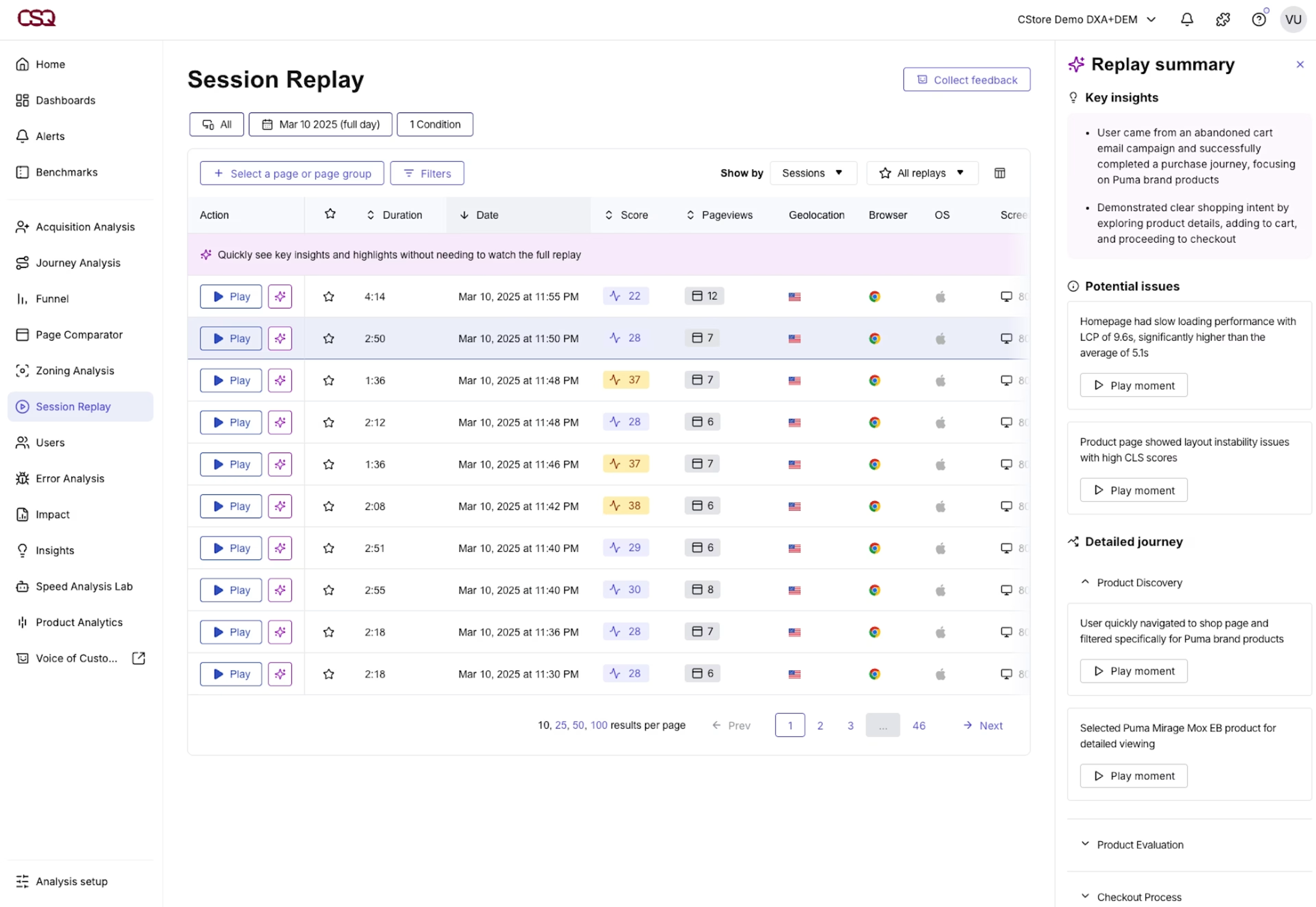This guide takes you through seven diverse funnel examples from websites and products. You’ll see how to visualize your funnels and troubleshoot drop-offs to build an optimized sales funnel for your audience.
1. An ecommerce funnel with a checkout problem
Most ecommerce funnels look something like this:
Homepage > Category Page > Product Page > Basket > Checkout > Order Confirmation
But, in reality, the customer journey is never that linear. People don’t navigate neatly from A to B to C (we wish they did!)—the checkout process alone might involve multiple pages, including a customer login.
That was the case for plant-based snack producer Wyldsson, whose funnel data showed a massive drop-off in users during checkout after launching a new online store.
![[visual] An example six-step eco](http://images.ctfassets.net/gwbpo1m641r7/7r1UPjviMyW6Ah0W0rkjPH/a9fdf7e8604287c4d5e1b6a433e5b4ae/funnel-example.png?w=1920&q=100&fit=fill&fm=avif)
An example six-step ecommerce funnel
Using tools like heatmaps and session recordings, the Wyldsson team investigated the drop-off and found 2 critical bugs.
Users on certain browsers were getting their carts emptied when trying to checkout
Existing customers were logging in before adding items to the cart, getting them stuck in a loop that prevented them from going back to the store to make a purchase
After seeing these issues from their customers’ perspectives, the team fixed them and achieved a +30% increase in sales.
![[visual] A move map on Wyldsson’s homepage](http://images.ctfassets.net/gwbpo1m641r7/1Y1lsZ3ERU9X822Iyys0Yi/e6020b8d404395d81a8ed816cbb6b738/Wyldsson-heatmap.jpg?w=1920&q=100&fit=fill&fm=avif)
A move map on Wyldsson’s homepage
🔻 If this was your funnel
Use a funnel tool like Contentsquare Funnels to visualize your ecommerce checkout funnel
Investigate drop-offs using experience intelligence tools like Heatmaps and Session Replays to find out why people aren’t converting
Monitor your funnel regularly to spot negative changes in conversion rate between pages, especially after a redesign or new launch
Optimize your ecommerce funnel by starting at the bottom and fixing issues near the point of conversion first
2. A mobile funnel with an invisible CTA
Not all funnels end in sales or sign-ups. Some, like this B2B funnel example from fleet management SaaS platform Vimcar, are designed to collect leads.
![[visual] Vimcar’s 3-page mobile demo si](http://images.ctfassets.net/gwbpo1m641r7/7Ck18lXtlOHrugMfRDVfXy/02bfffd8640e34e3903312f21037f50d/Vimcar-funnel.jpg?w=1920&q=100&fit=fill&fm=avif)
Vimcar’s 3-page mobile demo sign-up funnel on mobile, with optimized CTAs
Vimcar’s three-page demo sign-up funnel takes website visitors from the homepage to a product overview page to a demo lead form. After launching a website redesign, the team spotted a reduction in conversion rate for demo sign-ups.
We need to respond early on if something's not working. Until we fix it, our funnel will generate fewer leads, which means fewer potential customers for our sales team.
Using heatmaps, the Vimcar team investigated the drop-off and found
Click maps revealing customers clicking on (unlinked) images instead of text
Scroll maps showing 75% of users on mobile not seeing the main CTA (call to action)
The team fixed these issues by linking commonly clicked images and moving the mobile CTA above the average fold, contributing to a +24% increase in demo sign-ups at the bottom of the funnel.
🔻 If this was your funnel
Monitor funnels for changes when you’re launching website updates
Use a tool like Contentsquare Heatmaps to see if you’re losing CTA clicks to unlinked assets
View scroll maps to find the average fold and ensure CTAs aren’t getting lost on both desktop and mobile
Segment your funnel data—in this case, it was mobile vs. desktop traffic—to find out if you’re losing conversions on specific devices or to target audience segments
3. A content funnel with an 82% drop-off
If you look online for lead generation and sales funnel ideas, you’ll likely hear about ‘gating’ content behind a contact information form to generate leads or build an email list. A lead funnel can show you how well you’re converting visitors into leads but also help you monitor if your digital marketing strategy is working as intended.
CMS Connected, an IT industry news and marketing company, monitored a gated content piece’s performance using a three-step funnel:
Landing Page > Sign-up Form > Success Page
![[visual ] CMS Connected’s 3-step gate](http://images.ctfassets.net/gwbpo1m641r7/1p5KvkvVjAzyoRay48L7At/7d04595ad567c74777d93f0b9f8359a6/CMS-Connected-funnel.jpg?w=1920&q=100&fit=fill&fm=avif)
CMS Connected’s 3-step gated content funnel
The CMS Connected team saw a massive drop-off of around 82% between the sign-up form and the success page. Instead of optimizing the form, they removed it from the funnel and gave all visitors free access to their content.
This led to a considerable increase in people reading CMS Connected’s content, which in turn allowed the company to showcase its expertise to more prospective customers and convert more people into clients further down the sales funnel.
🔻 If this was your funnel
Analyze how much traffic you’re losing behind gated content sign-up forms
Consider removing barriers if it will help funnel more people towards your end goal of sales or product sign-ups (remember: business metrics > marketing metrics)
4. A content marketing funnel that generates paying customers
Behavior insights tool Hotjar created full-funnel content clusters around topics that mattered to their audience. Each topic cluster covered content from the top, middle, and bottom of the funnel, like this:
TOFU > MOFU > BOFU
You may also see this described as Awareness > Consideration > Conversion or one of the many other variations on the standard marketing funnel.
![[visual] Hotjar’s marketing funnel, from o](http://images.ctfassets.net/gwbpo1m641r7/6tzBSpClDmlX7QdjIE9RzX/4bc926db0d3cc0595d46a59a9be4eeae/hotjar-funnel.jpeg?w=1920&q=100&fit=fill&fm=avif)
Hotjar’s marketing funnel, from organic search to guide landing page to product sign-up
Hotjar used SEO to drive organic traffic (mostly from Google Search) to guide pages, with most traffic going to the main guide page. Hotjar also had sub-chapters that take readers further into the topic (aka down the funnel).
Since people don’t browse neatly from TOFU to BOFU—watch session replays to see this for yourself—it’s important to optimize each piece of content for product sign-ups, even if it’s near the top of the funnel.
Here are the results of Hotjar’s funnel improvements for one of their recent guides:
+150% YoY increase in monthly organic visits
+130% YoY increase in organic sign-ups
+70% YoY increase in paying customers (from organic traffic)
Note: Hotjar is now part of the Contentsquare group, and the Content and SEO team implements the same best practices on the website to create an amazing journey and move users through the conversion and marketing funnel.
🔻 If this was your funnel
Monitor the success of your SEO, social media, or email marketing campaigns using a funnel from website entry to conversion
Watch session replays to see how real users browse your website before converting
If you’re using Contentsquare, filter insights by referrer URL (e.g. contains ‘google’) to see how visitors from different sources behave
Use experience intelligence tools to fix any UX issues on your blog or content pages that may negatively impact conversions
5. A product funnel with a broken sign-up form
Your funnel might bring in millions of visitors at the top, but any bugs or issues near the bottom will have an outsized impact on your conversions.
This lead funnel example from audience insights SaaS company Audiense highlights the importance of monitoring your funnel at all times.
![[visual ] Audiense’s product funnel, from home](http://images.ctfassets.net/gwbpo1m641r7/23xhzlbM0Gh5ta7KSJhPjx/d4f3aaef05ed39d2b5c6a9b1552ca67c/Audiense-funnel.jpg?w=1920&q=100&fit=fill&fm=avif)
Audiense’s product funnel, from homepage to free sign-up page, in a single step
Audiense offered users a free insights report if they signed up. The team noticed a huge drop in conversions on the sign-up page and used recordings to troubleshoot what was wrong.
They spotted a broken password validator blocking people from creating accounts, fixed the issue in a couple of hours, and saw conversions quickly return to normal.
![[visual] audiense logo](http://images.ctfassets.net/gwbpo1m641r7/6doLxGMiqOL1XOkjqRisD6/85e4ed1479a58e8fb9b4964d30c94b3a/png-clipart-audiense-logo-thumbnail-tech-companies-thumbnail.png?w=750&q=100&fit=fill&fm=avif)
We monitor our sales funnel to see where people abandon the sign-up page without converting, and one day we noticed a huge drop in conversions. We discovered that the autocomplete feature was broken, so we fixed it, and conversions went back up immediately.
🔻 If this was your funnel
Monitor your funnel and look out for sudden reductions in conversion rate or an increase in drop-offs—if you use Contentsquare, add custom funnels to the Contentsquare Dashboard, so they’re always in view
If you monitor funnels in Contentsquare Funnels, click straight through to view relevant session replays and troubleshoot conversion drops as soon as you spot them
![[Visual] funnels with steps detail](http://images.ctfassets.net/gwbpo1m641r7/5wErRPwFwHk9VWPEqPwMm9/23364e830e8245ee25b365ccc3321f44/funnels-with-steps-detail.png?w=1920&q=100&fit=fill&fm=avif)
Add custom funnels to the Contentsquare Dashboard to monitor conversion rates and drop-offs
6. A sales funnel with a broken pricing element
Funnels serve one important function: highlighting where visitors drop off. But that’s only the beginning. The team at Gogoprint, an online printing company, used funnels to identify not only where users were dropping off, but also why it was happening. 🕵️
![[visual] gogoprint logo](http://images.ctfassets.net/gwbpo1m641r7/BiNIilAO6aRIotlVIMxdK/be6d9377d14260c095d96568940a7548/VOC_gogoprint_logo_black_4deddfa4eb.png?w=1920&q=100&fit=fill&fm=avif)
Funnels help me identify where in the customer journey people drop off. Recorded user sessions let me understand what people see when they arrive on our website—what they click and what they don’t click. Heatmaps helped me identify where they spend most of their time and assess if they should be spending time there or not.
Using heatmaps and recordings, the Gogoprint team identified a design issue in the pricing table that caused visitors to bounce. They A/B tested several solutions, eventually settling on a hover element that let people know how to proceed when hovering over a price. Funnel drop-offs on the product page decreased by -7%, and conversion rate increased by +2%.
![[visual] A screenshot from a session recording that h](http://images.ctfassets.net/gwbpo1m641r7/5LaG0pjpSE3jW7QGPtX7as/f23cef8e07731e0826d63a70f9ad4fd2/Gogoprint-replay.png?w=1920&q=100&fit=fill&fm=avif)
A screenshot from a session recording that helped the Gogoprint team find a funnel-blocking bug in their pricing table
🔻 If this was your funnel
Use funnels as a starting point to find pages with high drop-offs
Investigate the user behavior using tools like Contentsquare Session Replay to see how real people navigate across specific pages
Go a step further and filter recordings by exit page to find out where people got stuck before they dropped off your funnel (and save it as a segment for quick access next time)

Filter Contentsquare session replays by page exits to troubleshoot funnel drop-offs
7. An onboarding funnel with UX issues
For software companies, optimizing the onboarding funnel to deliver quick value to new users is essential for customer retention—especially if you need to convert free trial users into new customers.
This was the case for DashThis, a marketing reporting dashboard tool, whose onboarding funnel began like this:
Free Trial Sign Up Page > Add Integration Page > Add Data Source Page
![[visual] The first few steps of DashT](http://images.ctfassets.net/gwbpo1m641r7/16vDlP72LAfRKQhLBiRH1d/cf0f5544169ee47569689ca2c3dd3b9c/DashThis-funnel.jpg?w=1920&q=100&fit=fill&fm=avif)
The first few steps of DashThis’s onboarding funnel
Funnel analysis showed about 60% of users dropped off the funnel at the first step, long before they could get value from the tool. Using replays to investigate why, they found that users didn’t always know where to click next because buttons weren’t clear on all screen resolutions. On top of that, users seemed to get lost in the list of 30+ integrations.
They implemented the following changes:
Making buttons larger and higher up the page
Adding a search bar, and incorporating pop-ups
Videos to guide users through the process
This resulted in a +50% increase in onboarding funnel completions after just a couple of months, including a +25% increase in conversions at the first step.
🔻 If this was your funnel
Sometimes you need to start optimizing your funnel from the top down: use a tool like Contentsquare Session Replay to find usability issues that stop users from progressing down the funnel
Be your own best sales funnel example
There’s no magic blueprint for building the perfect funnel. But if you learn anything from the funnel examples above, let it be this: any funnel can be optimized if you track where users are dropping off, investigate why, implement fixes, and repeat.
And if you use Contentsquare Funnels alongside our behavior analytics tools, you’ll be able to monitor, troubleshoot, and share all your sales, marketing, and conversion funnels in one place.
And, who knows—maybe your next funnel will be used as an example in a best funnels listicle. 😉
![[visual][Funnels] Examples](http://images.ctfassets.net/gwbpo1m641r7/4gI3gETVgQ2WTBafdcWbdS/ad0cf36bb9be0b3835f8058e08a09b31/-Funnels-_Examples.png?w=3840&q=100&fit=fill&fm=avif)
